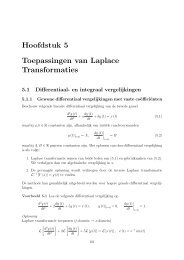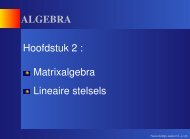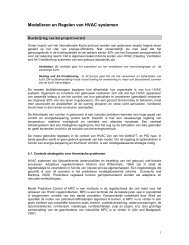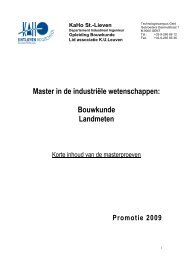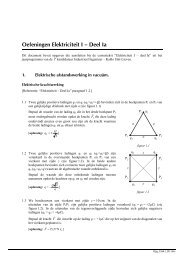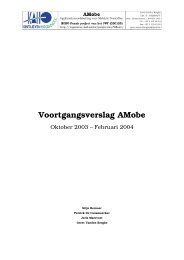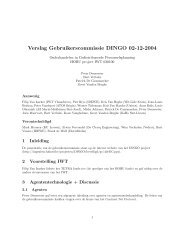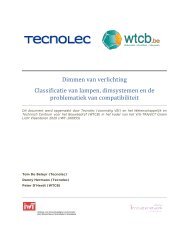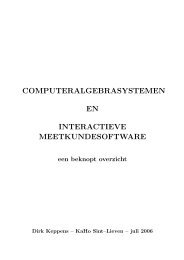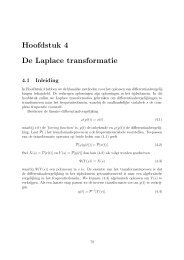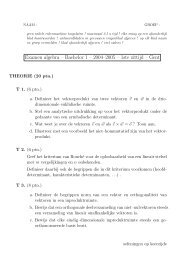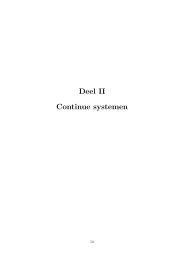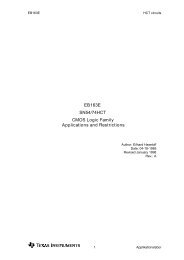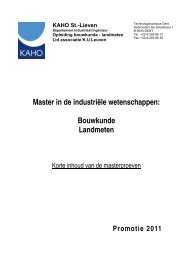Manuscript Guidelines - Springer
Manuscript Guidelines - Springer
Manuscript Guidelines - Springer
Create successful ePaper yourself
Turn your PDF publications into a flip-book with our unique Google optimized e-Paper software.
ABC<br />
springer.com<br />
<strong>Manuscript</strong> <strong>Guidelines</strong>
springer.com<br />
Contents<br />
1 Introduction ................................................................................................................ 2<br />
2 <strong>Manuscript</strong> Preparation Tools for Word and LaTeX .................................................... 2<br />
3 Permissions ................................................................................................................. 3<br />
4 <strong>Manuscript</strong> Preparation .............................................................................................. 3<br />
4.1 Front Matter ....................................................................................................... 3<br />
4.1.1 Title Page ..................................................................................................... 3<br />
4.1.2 Foreword (optional) .................................................................................... 4<br />
4.1.3 Preface (optional)........................................................................................ 4<br />
4.1.4 Table of Contents ........................................................................................ 4<br />
4.1.5 List of Abbreviations (optional)................................................................... 4<br />
4.2 Chapters .............................................................................................................. 4<br />
4.2.1 Language ..................................................................................................... 5<br />
4.2.2 Chapter Title and Authors ........................................................................... 5<br />
4.2.3 Abstract ....................................................................................................... 5<br />
4.2.4 Keywords (if applicable) .............................................................................. 5<br />
4.2.5 Headings and Heading Numbering .............................................................. 6<br />
4.2.6 Terminology, Units and Abbreviations ........................................................ 6<br />
4.2.7 Formal Style and Text Formatting ............................................................... 6<br />
4.2.8 Footnotes .................................................................................................... 7<br />
4.2.9 Equations and Program Code ...................................................................... 7<br />
4.3 Tables .................................................................................................................. 7<br />
4.4 Figures and Illustrations ...................................................................................... 8<br />
4.4.1 Numbering .................................................................................................. 8<br />
4.4.2 Figure Captions ........................................................................................... 8<br />
4.4.3 Figure and Illustration Files ......................................................................... 8<br />
4.5 References .......................................................................................................... 9<br />
4.5.1 Reference Citations ..................................................................................... 9<br />
4.5.2 Reference List .............................................................................................. 9<br />
4.5.3 Reference Styles .......................................................................................... 9<br />
4.6 Back Matter ....................................................................................................... 10<br />
4.6.1 Appendix ................................................................................................... 10<br />
4.6.2 Index (if applicable) ................................................................................... 10<br />
5 Final Check and Submission ...................................................................................... 11<br />
<strong>Manuscript</strong> Submission Checklist ................................................................................. 12<br />
<strong>Manuscript</strong> <strong>Guidelines</strong> 1.0 | February 2013 1
springer.com<br />
1 Introduction<br />
Publishing a book is a joint effort between you and <strong>Springer</strong>. We feel it is important that our authors<br />
concentrate on the content of the chapter or a book. When writing a book for <strong>Springer</strong>, please do not be<br />
concerned with the final layout. That is <strong>Springer</strong>’s role. To ensure that we always keep pace with all current<br />
online and print requirements, <strong>Springer</strong> structures the content in XML as the basis for presentation<br />
in print or in digital formats for such devices as Amazon Kindle, Apple iPad/iPhone, and Google Android.<br />
We utilize standard layouts with style specifications suitable for multiple display formats.<br />
• What advantages do these provide for you in manuscript preparation? It means you can focus on the<br />
content and <strong>Springer</strong> will professionally typeset the book and, with XML structuring, will ensure that<br />
your content will be available to readers in many formats for many years to come. To ensure this<br />
works, please follow the instructions for manuscript formatting, preparation, and delivery under<br />
<strong>Manuscript</strong> Preparation. For Lecture Notes in Computer Series (LNCS) preparation guidelines click<br />
here.<br />
Tip<br />
A key part of the publication process (and in response to the changing requirements of the book industry)<br />
is the standard corporate book covers that <strong>Springer</strong> introduced for each subject area which<br />
it publishes. These covers provide a strong, corporate brand identity for <strong>Springer</strong> books, making<br />
them instantly recognizable amongst the scientific community. In addition the covers also assist the<br />
speed of publication, as having standardized versions greatly reduces the time traditionally spent on<br />
creating individual covers for each title.<br />
2 <strong>Manuscript</strong> Preparation Tools for Word and LaTeX<br />
• <strong>Springer</strong> provides manuscript preparation tools for Word and LaTeX users that help structure the<br />
manuscript, e.g., define the heading hierarchy. Predefined style formats are available for all the<br />
necessary structures that are supposed to be part of the manuscript, and these formats can be<br />
quickly accessed via hotkeys or special toolbars.<br />
Note: These tools are not intended for the preparation of the final page layout. The final layout will<br />
be created by <strong>Springer</strong> according to our layout specifications.<br />
►<strong>Manuscript</strong> preparation tool for Word<br />
►LaTeX2e macro packages for monographs and for contributed books<br />
• The usage of these tools is not mandatory. Alternatively, you may either use a blank Word document<br />
or the standard LaTeX book class (for monographs) or article class (for individual contributions)<br />
and apply the default settings and styles (e.g., for heading styles, lists, footnotes, etc.).<br />
Tip<br />
If you cannot use our Word tool:<br />
– Open a blank Word document.<br />
– Use the default styles in Word to identify the heading levels.<br />
– Use the standard Word functions for displayed lists, type styles such as bold or italics, the indexing<br />
function, and the footnote function.<br />
– Use a single main font for the entire text. We recommend Times New Roman.<br />
– For special characters, please use Symbol and/or Arial Unicode.<br />
<strong>Manuscript</strong> <strong>Guidelines</strong> 1.0 | February 2013 2
springer.com<br />
3 Permissions<br />
• If excerpts from copyrighted works (including websites) such as illustrations, tables, animations,<br />
or text quotations are included in your manuscript, please obtain permission from the copyright<br />
holder (usually the original publisher) for both the print and online format.<br />
• Some publishers such as <strong>Springer</strong> have entrusted the Copyright Clearance Center in the US to<br />
manage the copyright permission procedure on their behalf. Please contact RightsLink for further<br />
information. Alternatively, <strong>Springer</strong> can provide you with a template to use when requesting<br />
permissions.<br />
►RightsLink<br />
• Please comply with the instructions stipulated in the permission(s) concerning acknowledgements<br />
or credit lines within your manuscript (e.g., reference to the copyright holder in captions) and<br />
keep the written confirmation of the permission in your possession with the copy of your manuscript.<br />
• Please be aware that some publishers do not always grant right of reproduction for free due to<br />
different reasons. <strong>Springer</strong> will not be able to refund any costs that may have been incurred in receiving<br />
these permissions. As an alternative, material from other sources should be used.<br />
4 <strong>Manuscript</strong> Preparation<br />
To guarantee a smooth publication process and a seamless transformation of your manuscript into the<br />
final layout and various electronic formats (e.g., HTML for online publication, ePub for e-book readers),<br />
the manuscript needs to be structured as follows:<br />
• Front Matter: Title page, Dedication (optional), Foreword (optional), Preface (optional), Table of<br />
Contents, List of abbreviations (optional).<br />
• Text Body: It comprises the chapters containing the content of the book, i.e., text, figures, tables,<br />
and references. Chapters can be grouped together in parts.<br />
• Back Matter: After the last chapter, the back matter can contain an appendix, a glossary, and/or<br />
an index, all of which are optional.<br />
4.1 Front Matter<br />
The title page and the table of contents precede the actual content of a book.<br />
The preface (optional) should be about the book: why it was written, who it is for, its organization, or<br />
the selection of contributors. An introduction to the subject of the book, however, should appear as the<br />
first chapter of the book.<br />
Other optional items in the front matter at the beginning of a book are e.g., dedication, a foreword<br />
or a list of abbreviations.<br />
4.1.1 Title Page<br />
• Please include all author names (for contributed books, the editor names) and their affiliations,<br />
the book title and subtitle. Ensure that the sequence of the author names is correct and the title<br />
of your book is final when you submit your manuscript.<br />
• Please also supply all the email addresses and telephone numbers and in case of multiple authors<br />
or editors, clearly indicate the corresponding author or editor.<br />
<strong>Manuscript</strong> <strong>Guidelines</strong> 1.0 | February 2013 3
springer.com<br />
• Once the manuscript has been delivered to <strong>Springer</strong> Production, changes to title or authorship are<br />
no longer possible.<br />
4.1.2 Foreword (optional)<br />
• If you intend to include a foreword, please submit it with the manuscript.<br />
Tip<br />
– A foreword is usually written by an authority on the subject, and serves as a recommendation of<br />
the book.<br />
– The name of the foreword’s contributor is always given at the end of the foreword; affiliations<br />
and titles are generally not included, but the date and place of writing may be.<br />
4.1.3 Preface (optional)<br />
• A preface should not contain a reference list.<br />
• An introduction to the subject of the book should not be confused with a preface. The introduction<br />
does not belong in the front matter, but should appear as the first chapter of the book.<br />
Tip<br />
– The preface should be about the book: why it was written, who it is for, its organization, or the<br />
selection of contributors.<br />
– Acknowledgments of support or assistance in preparing the book can be included as the last paragraph(s)<br />
of the preface. If the acknowledgment is more than one page long, it should start on a<br />
separate page under the heading Acknowledgments.<br />
4.1.4 Table of Contents<br />
• List all parts, chapters, and back matter material (e.g., an index) in the final sequence.<br />
• If your chapters are numbered, use Arabic numerals and number the chapters consecutively<br />
throughout the book (Chapter 1, Chapter 2, etc.), i.e., do not start anew with each part.<br />
1<br />
• If there are parts, use Roman numerals for parts (Part I, Part II, etc.).<br />
Key Style Points: Table of Contents<br />
4.1.5 List of Abbreviations (optional)<br />
Tip<br />
– A list of abbreviations and/or symbols is optional but it may be very helpful if numerous abbreviations<br />
and special symbols are scattered throughout the text.<br />
4.2 Chapters<br />
Chapters contain the actual content of the book, i.e., text, figures, tables, and references. Chapters can<br />
be grouped together in parts; subparts are not possible. Only one chapter (i.e., an introduction) may<br />
precede the first part and would be the first chapter.<br />
• Decide the numbering style for the chapters and apply this style consistently to all chapters: consecutively<br />
numbered (monographs or textbooks) or unnumbered (contributed volumes).<br />
• If an introduction to the subject of the book (historical background, definitions, or methodology)<br />
is included, it should appear as the first chapter and thus be included in the chapter numbering. It<br />
can contain references, figures, and tables, just as any other chapter.<br />
<strong>Manuscript</strong> <strong>Guidelines</strong> 1.0 | February 2013 4
springer.com<br />
4.2.1 Language<br />
• Either British or American English can be used, but be consistent within your chapter or book. In<br />
contributed books chapter-wise consistency is accepted.<br />
• Check for consistent spelling of names, terms, and abbreviations, including in tables and figure<br />
captions.<br />
Tip<br />
– For American spelling please consult Merriam–Webster's Collegiate Dictionary; for British<br />
spelling you should refer to Collins English Dictionary.<br />
– If English is not your native language, please ask a native speaker to help you or arrange for your<br />
text to be checked by a professional editing service. Please insert their final corrections into your<br />
data before submitting the manuscript.<br />
►More about language editing<br />
4.2.2 Chapter Title and Authors<br />
1<br />
• For contributed volumes, please include each chapter’s authors’ names (spelled out as they would<br />
be cited), affiliations and e-mail addresses and telephone numbers after the chapter title.<br />
(The telephone number will not be published but may be needed as contact information during<br />
the publishing process.)<br />
Key Style Points: Chapter Title Page<br />
4.2.3 Abstract<br />
• Begin each chapter with an abstract that summarizes the content of the chapter in 150 to 250<br />
words. The abstract will appear online at <strong>Springer</strong>Link and be available with unrestricted access to<br />
facilitate online searching, using, e.g., Google, and allow unregistered users to read the abstract<br />
as a teaser for the complete chapter<br />
• If no abstract is submitted, we will use the first paragraph of the chapter instead.<br />
• Abstracts appear only in the printed edition of contributed volumes unless stipulated otherwise.<br />
Tip<br />
– Don’t include reference citations or undefined abbreviations in the abstract, since abstracts are<br />
often read independently of the actual chapter and without access to the reference list.<br />
– For further tips on writing an effective abstract, see the website on Search Engine Optimization.<br />
4.2.4 Keywords (if applicable)<br />
• Some books also publish keywords. Please check with the editor of your book or with the publishing<br />
editor to see if keywords are required.<br />
Tip<br />
– Each keyword should not contain more than two compound words, and each keyword phrase<br />
should start with an uppercase letter.<br />
– When selecting the keywords, think of them as terms that will help someone locate your chapter<br />
at the top of the search engine list using, for example, Google. Very broad terms (e.g., ‘Case<br />
study’ by itself) should be avoided as these will result in thousands of search results but will not<br />
result in finding your chapter.<br />
<strong>Manuscript</strong> <strong>Guidelines</strong> 1.0 | February 2013 5
springer.com<br />
4.2.5 Headings and Heading Numbering<br />
• Heading levels should be clearly identified and each level should be uniquely and consistently<br />
formatted and/or numbered.<br />
• Use the decimal system of numbering if your headings are numbered.<br />
1<br />
• Never skip a heading level. The only exceptions are run-in headings which can be used at any hierarchical<br />
level.<br />
Key Style Points: Headings<br />
Tip<br />
– In cross-references, for hyperlink purposes, refer to the chapter or section number (e.g., see<br />
Chap. 3 or see Sect. 3.5.1).<br />
– In addition to numbered headings, two more (lower) heading levels are possible. Their hierarchical<br />
level should be identified with the help of <strong>Springer</strong>’s templates or the standard Word or<br />
LaTeX heading styles.<br />
– Another option for lower level headings is a run-in heading, i.e., headings that are set immediately<br />
at the beginning of the paragraph. Such headings should be formatted in bold or italics.<br />
4.2.6 Terminology, Units and Abbreviations<br />
• Technical terms and abbreviations should be defined the first time they appear in the text.<br />
• Please always use internationally accepted signs and symbols for units, so-called SI units.<br />
1<br />
• Numerals should follow the British/American method of decimal points to indicate decimals and<br />
commas to separate thousands.<br />
Key Style Points: Abbreviations, Numbers, Units and Equations<br />
Tip<br />
– If the manuscript contains a large number of terms and abbreviations, a list of abbreviations or a<br />
glossary is advised.<br />
4.2.7 Formal Style and Text Formatting<br />
1<br />
• <strong>Manuscript</strong>s will be checked by a copy editor for formal style. <strong>Springer</strong> follows certain standards<br />
with regard to the presentation of the content, and the copy editors make sure that the manuscript<br />
conforms to these styles.<br />
Key Style Points: Formal Style, Text formatting<br />
Tip<br />
– Remember not to make changes that involve only matters of style when you check your proofs.<br />
We have generally introduced forms that follow <strong>Springer</strong>’s house style.<br />
Emphasis and special type<br />
1<br />
Key Style Points: Formal Style, Text formatting<br />
Tip<br />
– Italics should be used for emphasized words or phrases in running text, but do not format entire<br />
paragraphs in italics.<br />
– In addition, use italics for species and genus names, mathematical/physical variables, and prefixes<br />
in chemical compounds.<br />
– Bold formatting should only be used for run-in headings and small capitals for indicating optical<br />
activity (D- and L-dopa).<br />
<strong>Manuscript</strong> <strong>Guidelines</strong> 1.0 | February 2013 6
springer.com<br />
Boxes<br />
– Sans serif (e.g., Arial) and nonproportional font (e.g., Courier) can be used to distinguish the literal<br />
text of computer programs from running text.<br />
• Do not set entire pages as boxes, because this affects online readability.<br />
Tip<br />
– Additional text elements for professional and text books such as examples, questions or exercises,<br />
summaries or key messages can be highlighted with <strong>Springer</strong>’s manuscript preparation tool. If<br />
you do not use the tool, use a consistent style for each of these elements and submit a list of the<br />
styles used together with your manuscript.<br />
4.2.8 Footnotes<br />
• Always use footnotes instead of endnotes and never use footnotes instead of a reference list.<br />
1<br />
• Footnotes should not consist of a reference citation. Footnotes should not contain figures, tables<br />
and/or the bibliographic details of a reference.<br />
Key Style Points: Formal Style, Text formatting<br />
4.2.9 Equations and Program Code<br />
• In Word, use the Math function of Word 2007 or 2010, MathType, or Microsoft Equation Editor<br />
with Word 2003 to create your equations, and insert the graphic into your text file as an object.<br />
1<br />
• In LaTeX, use the Math environment to create your equations.<br />
Key Style Points: Abbreviations, Numbers, Units and Equations<br />
Tip<br />
– Prepare the whole equation in this way and not just part of it.<br />
4.3 Tables<br />
• Give each table a caption. Add a reference citation to the table source at the end of the caption, if<br />
necessary.<br />
• Number tables consecutively using the chapter number (e.g. Table 1.1 for the first table in<br />
Chap. 1) and ensure that all tables are cited in the text in sequential order. Do not write “the following<br />
table”.<br />
1<br />
• Use the table function to create and format tables. Do not use the space bar or multiple tabs to<br />
separate columns and do not use Excel to create tables as this can cause problems when converting<br />
your tables into the typesetting program and other formats.<br />
Key Style Points: Tables and Lists<br />
Tip<br />
– Simple, one-column lists should not be treated as tables. Use the displayed list function instead.<br />
– Save the tables in the same file as text, references, and figure captions.<br />
– Do not manually insert table rules in the manuscript, because they cannot be retained.<br />
<strong>Manuscript</strong> <strong>Guidelines</strong> 1.0 | February 2013 7
springer.com<br />
4.4 Figures and Illustrations<br />
4.4.1 Numbering<br />
• Number the figures chapter-wise using the chapter number (e.g., Fig. 1.1 for the first figure in<br />
Chap. 1) and ensure that all figures are cited in the text in sequential order. Do not write “the following<br />
figure”.<br />
4.4.2 Figure Captions<br />
• Give each figure a concise caption, describing accurately what the figure depicts. Include the captions<br />
at the end of the text file, not in the figure file.<br />
• Identify all elements found in the figure in the figure caption and use boxes, circles, etc. as coordinate<br />
points in graphs instead of color lines.<br />
1<br />
• If a figure is reproduced from a previous publication, include the source as the last item in the<br />
caption.<br />
Key Style Points: Figures and Illustrations<br />
4.4.3 Figure and Illustration Files<br />
A figure is an object that is drawn or photographed. It does not consist solely of characters and thus<br />
cannot be keyed.<br />
• Do not submit tabular material as figures.<br />
• Graphics and diagrams should be saved as EPS files with the fonts embedded. Microsoft Office<br />
files (Excel or PowerPoint) can be submitted in the original format (xls, xlsx, ppt, pptx). Scanned<br />
graphics in TIFF format should have a minimum resolution of 1200 dpi.<br />
• Photos or drawings with fine shading should be saved as TIFF with a minimum resolution of<br />
300 dpi.<br />
• A combination of halftone and line art (e.g., photos containing line drawings or extensive lettering,<br />
color diagrams, etc.) should be saved as TIFF with a minimum resolution of 600 dpi.<br />
Tip<br />
– Color figures will appear in color in the eBook but may be printed in black and white. In that<br />
case, do not refer to color in the captions and make sure that the main information will still be<br />
visible if converted to black and white. A simple way to check this is to make a black and white<br />
printout to see if the necessary distinctions between the different colors are still apparent. Color<br />
illustrations should be submitted as RGB (8 bits per channel).<br />
– Ensure consistency by using similar sizing and lettering for similar figures. Ideally, you should size<br />
figures to fit in the page or column width. For books in <strong>Springer</strong>’s standard format, the figures<br />
should be 78 mm or 117 mm (3 or 4 1/2 inches) wide and not higher than 198 mm (7 3/4 inches).<br />
– To add lettering, it is best to use Helvetica or Arial (sans serif fonts) and avoid effects such as<br />
shading, outline letters, etc. Keep lettering consistently sized throughout your final-sized artwork,<br />
usually about 2–3 mm (8–12 pt). Variance of type size within an illustration should be minimal,<br />
e.g., do not use 8-pt type on an axis and 20-pt type for the axis label.<br />
<strong>Manuscript</strong> <strong>Guidelines</strong> 1.0 | February 2013 8
springer.com<br />
4.5 References<br />
4.5.1 Reference Citations<br />
• Cite references in the text with author name/s and year of publication in parentheses (“Harvard<br />
system”):<br />
– One author: (Miller 1991) or Miller (1991)<br />
– Two authors: (Miller and Smith 1994) or Miller and Smith (1994)<br />
– Three authors or more: (Miller et al. 1995) or Miller et al. (1995)<br />
• If it is customary in your field, you can also cite with reference numbers in square brackets either<br />
sequential by citation or according to the sequence in an alphabetized list:<br />
– [3, 7, 12].<br />
4.5.2 Reference List<br />
• Include a reference list at the end of each chapter so that readers of single chapters of the eBook<br />
can make full use of the citations. References at the end of the book cannot be linked to citations<br />
in the chapters. Please do not include reference lists at the end of a chapter section, at the end of<br />
a book part, in a preface or an appendix.<br />
• Include all works that are cited in the chapter and that have been published (including on the Internet)<br />
or accepted for publication. Personal communications and unpublished works should only<br />
be mentioned in the text. Do not use footnotes as a substitute for a reference list.<br />
• Entries in the list must be listed alphabetically except in the numbered system of sequential citation.<br />
The rules for alphabetization are:<br />
– First, all works by the author alone, ordered chronologically by year of publication.<br />
– Next, all works by the author with a coauthor, ordered alphabetically by coauthor.<br />
– Finally, all works by the author with several coauthors, ordered chronologically by year of publication.<br />
Tip<br />
– For authors using EndNote software to create the reference list, <strong>Springer</strong> provides output styles<br />
that support the formatting of in-text citations and reference list.<br />
► EndNote software: <strong>Springer</strong> reference styles<br />
– For authors using BiBTeX, the style files are included in <strong>Springer</strong>’s LaTex package.<br />
4.5.3 Reference Styles<br />
<strong>Springer</strong> follows certain standards with regard to the presentation of the reference list. They are based<br />
on reference styles that were established for various disciplines in the past and have been adjusted to<br />
facilitate automated processing and citation linking. This allows us, for example, to easily cross link the<br />
cited references with the original publication.<br />
Tip<br />
– Always select one of the reference list styles that are supported by <strong>Springer</strong> and suits your publication<br />
best or follow the instructions received from your book editor. There are, however, recommended<br />
styles depending on the discipline.<br />
– The copy editor will check the references against the reference style applicable for the book and<br />
correct the format if necessary.<br />
<strong>Manuscript</strong> <strong>Guidelines</strong> 1.0 | February 2013 9
springer.com<br />
<strong>Springer</strong> Style<br />
Disciplines<br />
Key Style Points:<br />
Reference styles<br />
EndNote software:<br />
<strong>Springer</strong> reference<br />
styles<br />
<strong>Springer</strong> Basic Style<br />
Based on Harvard style and recommendations<br />
of the Council of<br />
Biology Editors (CBE)<br />
Medicine, Biomedicine, Life<br />
Sciences, Chemistry, Geosciences,<br />
Computer Science, Engineering,<br />
Economics<br />
<strong>Springer</strong> Basic Style<br />
<strong>Springer</strong> Basic End-<br />
Note Style<br />
<strong>Springer</strong> Vancouver Style<br />
Based on the NLM guidelines Citing<br />
Medicine<br />
Medicine, Biomedicine<br />
<strong>Springer</strong> Vancouver<br />
Style<br />
<strong>Springer</strong> Vancouver<br />
EndNote Style<br />
<strong>Springer</strong> MathPhys Style<br />
Mathematics, Physics, Statistics<br />
<strong>Springer</strong> MathPhys<br />
Style<br />
<strong>Springer</strong> MathPhys<br />
EndNote Style<br />
<strong>Springer</strong> Physics Style<br />
Based on the reference list style<br />
of the American Physical Society<br />
(APS)<br />
Physics<br />
<strong>Springer</strong> Physics<br />
Style<br />
<strong>Springer</strong> Physics<br />
EndNote Style<br />
<strong>Springer</strong> SocPsych Style<br />
Based on the reference list style<br />
that was established by the<br />
American Psychological Association<br />
(APA)<br />
Social Sciences, Psychology<br />
<strong>Springer</strong> SocPsych<br />
Style<br />
<strong>Springer</strong> SocPsych<br />
EndNote Style<br />
<strong>Springer</strong> Humanities Style<br />
Based on the reference list style<br />
as suggested by the Chicago<br />
Manual of Style (15 th edn.)<br />
Humanities, Linguistics, Philosophy<br />
<strong>Springer</strong> Humanities<br />
Style<br />
<strong>Springer</strong> Humanities<br />
EndNote Style<br />
4.6 Back Matter<br />
After the last chapter, the back matter of the book can contain an appendix, a glossary, and/or an index.<br />
• Do not include a reference list containing the cited literature in the back matter, as references are<br />
then not linked to citations in the chapters. Instead, include reference lists at the end of each<br />
chapter. A list of further reading may be included in the back matter.<br />
4.6.1 Appendix<br />
• An appendix cannot include a reference list.<br />
Tip<br />
– Include important original content within a chapter or a chapter appendix, not in the book appendix,<br />
as any appendix in the back matter of a book will appear with unrestricted access in the<br />
eBook on <strong>Springer</strong>Link.<br />
4.6.2 Index (if applicable)<br />
• If an index is desired, please submit the index entries with the manuscript.<br />
Tip<br />
– Use the indexing function in Word or the index command in LaTeX to identify the index term as<br />
you write your text and indicate, on average, one or two index entry terms per manuscript page<br />
to be included in the index.<br />
<strong>Manuscript</strong> <strong>Guidelines</strong> 1.0 | February 2013 10
springer.com<br />
– Information should be listed under the term that most readers will probably look at first. Use<br />
cross-references to list variations or written-out versions and abbreviations/acronyms.<br />
– If you provide a list with index terms, the index, with page numbers, will be generated by our<br />
production partner.<br />
5 Final Check and Submission<br />
• Check the table of contents for the correct sequence of part, chapter and heading numbering and<br />
update the chapter titles and subheadings if necessary.<br />
• Save each chapter or contribution, including the accompanying references, figure legends, and<br />
tables, in a separate file in the original source file format and give each file your name and the<br />
chapter number (e.g., Myers-Chap1). Save the original figure files separately and name them with<br />
your name, the chapter, and figure number (e.g., Myers-Fig1.1).<br />
• Ensure the text and figures of your manuscript are complete and final and that you have kept to<br />
the agreed-upon length.<br />
• Submit your manuscript to your <strong>Springer</strong> Publishing Editor. Please include:<br />
– Original source files (Word, LaTeX) and figure files.<br />
– A PDF file of your manuscript and figure files, ideally with all fonts embedded, that can be used<br />
as a reference. This is especially important if text or figures contain special characters or unusual<br />
fonts. Please check the PDF to ensure that text appears as it should.<br />
• Ensure all third-party permissions have been obtained.<br />
• For contributed volumes, ensure that all signed Consent to Publish forms are enclosed in a separate<br />
folder.<br />
• Submission is possible via FTP (please contact your <strong>Springer</strong> Publishing Editor for access details).<br />
• Before you submit your final manuscript, use the following <strong>Manuscript</strong> Submission Checklist to<br />
make sure you have covered everything.<br />
<strong>Manuscript</strong> <strong>Guidelines</strong> 1.0 | February 2013 11
springer.com<br />
<strong>Manuscript</strong> Submission Checklist<br />
Title page Title (and subtitle) final o<br />
Authors/Editors All author/editor names included o<br />
Front matter<br />
e-mail address of corresponding author included<br />
Complete with the following elements:<br />
o Dedication o Foreword<br />
o Preface o Acknowledgments<br />
o Table of contents (required) o List of contributors<br />
o List of abbreviations<br />
o<br />
o<br />
Table of contents Monographs: first 2 levels of headings appearing in chapters are included o<br />
Contributed books: chapter titles and author names included<br />
Headings correspond to those in the text<br />
o<br />
o<br />
Book structure Number of parts: Number of chapters: o<br />
All chapters numbered sequentially throughout the book (or not numbered<br />
at all)<br />
Chapter sequence and numbering final<br />
o<br />
o<br />
Abstract Included for each chapter o<br />
Text Heading levels and special text elements consistently styled o<br />
No heading levels skipped<br />
o<br />
References Reference list included at the end of each chapter o<br />
Citations in text agree with reference list<br />
Reference list style according to <strong>Springer</strong>’s guidelines<br />
o<br />
o<br />
Figures All figures mentioned in text enclosed, complete, and as separate files o<br />
Consecutively numbered within chapter<br />
Consecutively cited in text<br />
Figure captions included at the end of the text file<br />
o<br />
o<br />
o<br />
Tables Prepared with the table function o<br />
Consecutively numbered within chapter<br />
Consecutively cited in text<br />
o<br />
o<br />
Electronic manuscript File folder/zip archive labeled with book title and author/editor name o<br />
Contributed books<br />
Each chapter saved as a separate file in the original file format<br />
Graphics saved as separate files in tif, eps, xls, xlsx, ppt, pptx format<br />
PDF file with all fonts embedded<br />
e-mail addresses and affiliation included for at least the corresponding author<br />
of each chapter<br />
Consent to publish for each chapter<br />
o<br />
o<br />
o<br />
o<br />
o<br />
Permissions Obtained for all material from other works o<br />
<strong>Manuscript</strong> <strong>Guidelines</strong> 1.0 | February 2013 12



